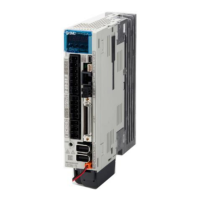In this step, confirm that the driver and servo motor operate normally.
With the servo motor disconnected from the machine, use the test operation
mode and check whether the servo motor correctly rotates at the slowest
speed. Refer to section 4.5.9 for the test operation mode.
In this step, confirm that the servo motor correctly rotates at the slowest
speed under the commands from the PC or PLC...etc.
Make sure that the servo motor rotates in the following procedure.
1) Switch on EM2 (Forced stop 2) and SON (Servo-on). When the driver is
put in a servo-on status, RD (Ready) switches on.
2) Switch on LSP (Forward rotation stroke end) and LSN (Reverse rotation
stroke end).
3) When a pulse train is input from the PC or PLC...etc, the servo motor
starts rotating. Give a low speed command at first and check the rotation
direction, etc. of the servo motor. If the machine does not operate in the
intended direction, check the input signal.
In this step, connect the servo motor with the machine and confirm that the
machine operates normally under the commands from the PC or PLC...etc.
Make sure that the servo motor rotates in the following procedure.
1) Switch on EM2 (Forced stop 2) and SON (Servo-on). When the driver is
put in a servo-on status, RD (Ready) switches on.
2) Switch on LSP (Forward rotation stroke end) and LSN (Reverse rotation
stroke end).
3) When a pulse train is input from the PC or PLC...etc, the servo motor
starts rotating. Give a low speed command at first and check the
operation direction, etc. of the machine. If the machine does not operate
in the intended direction, check the input signal. In the status display,
check for any problems of the servo motor speed, command pulse
frequency, load ratio, etc.
4) Then, check automatic operation with the program of the PC or PLC...etc.

